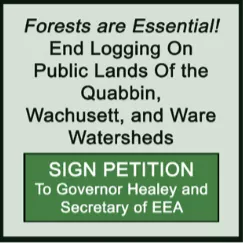Sustaining life on Earth depends on forests

Why preserve forests?
Forests optimize carbon storage, biodiversity, and ecosystem services.
Preservation of New England forests is critically important for their value as carbon sinks. When trees are cut, CO₂ is released immediately from the trees and soil. Protecting forests not only reduces carbon dioxide emissions from logging; protecting forests simultaneously draws down carbon from the atmosphere. There is no technology yet invented that can sequester carbon from the atmosphere like forests and trees. “Intact forests also may sequester half or more of their carbon as organic soil carbon or in standing and fallen trees that eventually decay and add to soil carbon.”
If left intact and undisturbed, “Northeast secondary forests have the potential to increase biological carbon sequestration between 2.3 and 4.2-fold.”
Protecting forests is essential for maintaining healthy ecosystems, preventing biodiversity collapse, and slowing the climate crisis. The global scientific consensus is "that safeguarding biodiversity and ecosystems is fundamental to climate resilient development."
|
|
Our Mission
The Forest Protection Team works to protect, preserve, and expand forests throughout Massachusetts in order to maximize carbon sequestration, promote biodiversity, and optimize human health. We raise public awareness and advocate for public policies that promote forest protection on local and state levels. Our work is guided by a commitment to environmental and social justice.
Learn more about our team's work.
The Forest Protection Team meets on the second Thursday of each month. Join us here. Click on an upcoming Forest Protection Team meeting date for more information.